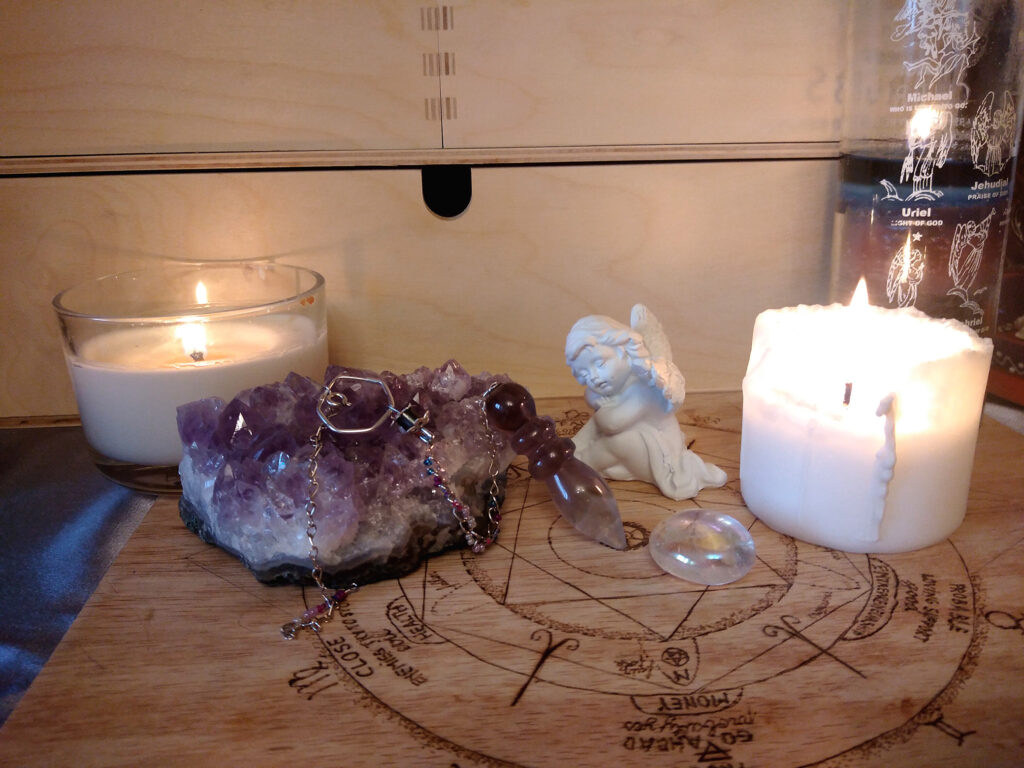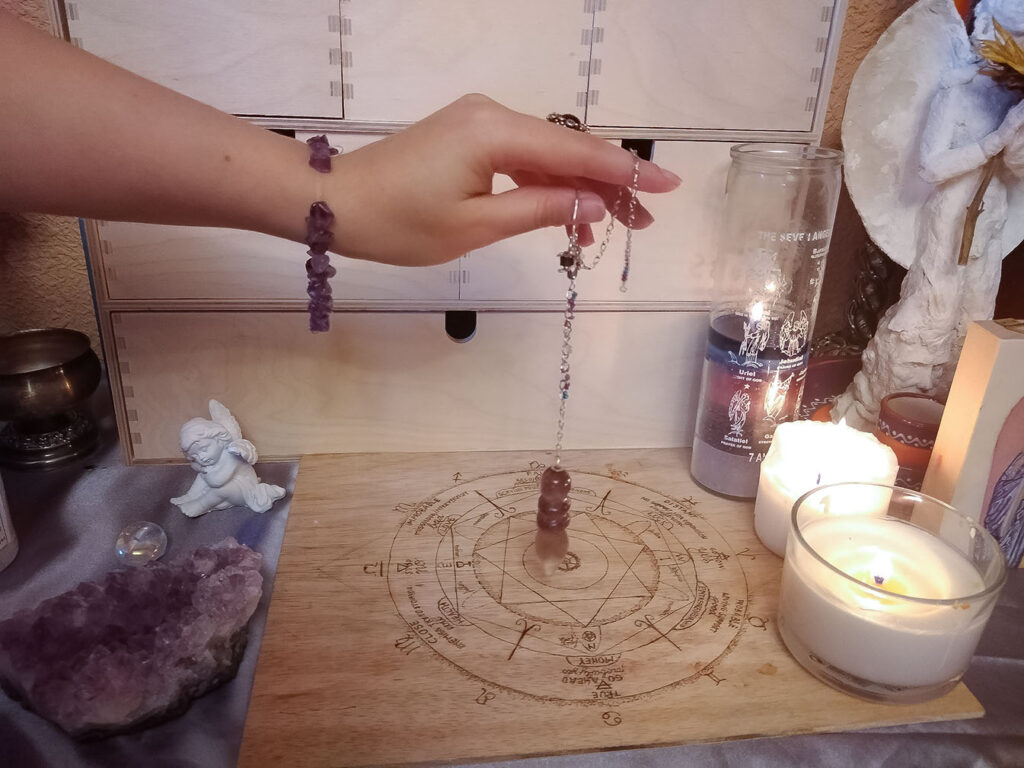Advanced Pendulum Divination – Get Better Readings
Pendulums as a spiritual tool
This is a form of dowsing that gained significant popularity due to its simplicity and mobility- it’s much easier to improvise and adapt to many challenges that plague other popular divination methods, such as tarot decks (metaphysical arguments aside, cards are very sensitive to dust and grime, and basically impossible to clean well, and ruining a deck is not ideal). It’s very easy to interpret a pendulum reading and connect with your chosen tool, and very easy to incorporate one in your own, original spells. It’s also easy to make one since it’s basically just a weight suspended from a pivot point, that can swing freely. You can use a string, ribbon, even strand of hair, an acorn, crystal, pebble, necklace or whatever has meaning to you, in order to create your own, personalized tool.
Unfortunately, most tutorials stop at showing you how to acquire one, store it, and cleanse it, but rarely go beyond “Yes/No” questions when really, pendulums work just as well for advanced, subtle readings. And they’re still much more convenient and durable than tarot cards!
The simple method and how pendulums work
This is the “common” way of divining the answer to your questions: once you acquire your pendulum and have spent some time connecting with it, figure out what movement means yes or no, and interpret the answers accordingly for your next questions. There are more ways to do this:
Ask the pendulum to show you “Yes.”
Simply hold it as still as you can, and say “Show me yes” or “What is yes?”. Wait until it moves. For many people, left-right or clockwise circles go for yes. It’s no rule, really, as all divination works by interpreting randomness. If anything, we expect the pendulum to move randomly- that’s the main thing we’re looking for, in order to interpret the answer, it shouldn’t be a controlled movement but an effortless, random swing. Once you found your positive answer, ask for no, and wait until it takes another trajectory. If it’s not clear, repeat until you get a consistent result.
Say something you are 100% sure is true.
The Earth is round. My name is (your name). Anything you know is true, then wait for the movement, as described above. That would be yes, or true, then say something you know is false, and wait for the No.
Program its movement.
This one is just a bit more advanced, in that you need to focus on your connection with your pendulum. Swing it deliberately in a way that makes sense for you as yes, such as left-right. Then declare, this is yes, and I will interpret it as such from now on. Repeat for no. It’s as if you declare a common language you will use for communication with your higher self, subconscious, deities, or the Universe, depending on what you’re working with.
After doing this, it’s very simple. You now know which movement means what, and having established this way of communicating (basically programming your pendulum), go ahead and use it the same way you would use any divination tools. Ask the question, hold it as still as you can, then focus as much as you can on the question and away from whatever you use to hold the pendulum as you wait for a movement to happen. Most keep it between fingers, but you can put it on a holder, hang it off a branch in nature, or anything with a connection to your question. (Follow your local laws, safety practices, and common sense when choosing the location.)

Advanced ways of reading
The major drawback of this method is it’s limited to the two options. Divination, at its core, interprets randomness based on the idea that all things are connected. By allowing some chance in our lives, we hope to get a feel of how things are going, basically testing our luck or fate in the current moment.
The movement of a pendulum is influenced by so many factors, such as air movement, friction, your ideomotor movements, and its weight, that it is unpredictable- random, for our purposes- enough for us to associate it with the uncontrolled “chance” of the moment. This movement of the pendulum, is, however, much more complex than a simple yes/no coin toss- and in general, the more outcomes the divination tool allows, the more complex and “advanced” it is generally perceived as, and the more accurate.
The reason for this is that our lives, and important matters, are rarely swinging between only two clear-cut, extreme options. A statement is rarely entirely true or false. While using the pendulum this way simplifies your practice and helps in certain situations, other times it’s more useful to get nuanced answers. But there’s no need to turn to complex and less practical methods such as augury (the ancient Roman practice of reading the movement of birds) or casting lots, as the pendulum provides enough nuance in itself.
Correspondences
This one is a less known, but very easily applied way of reading subtle influences- use the correspondences of the directions. You may need a compass or be able to guide yourself by the sun, moon, or stars if outside. There are generally two major “classical elements” correspondence tables in place: the eastern one, with five, and the Western one, with four. Each of those elements is associated with certain proprieties, a type of behavior and influences, and, most importantly for our purposes, cardinal directions.
Eastern/Western approaches to directions
The situation is much clearer with the five-element system of Eastern practices, which have traditionally established correspondences in feng shui, both in terms of properties and associated directions. These are easily accessible on the internet, and much better explained by people who practice this tradition. I do not consider myself an expert, or even knowledgeable enough to explain it properly, so I will leave it to the Feng Shui masters to explain the connection between the elements and the flow of Ki.
While using the Western one, there never was an “official” correspondence table, universally recognized. In fact, the idea of the four elements and directions is not universal in itself, as the alchemical traditions developed in the Northern Hemisphere. There is no universal source, but they probably established the correspondences by the properties of the elements (Cold/Hot and Dry/Wet), so the warmer, sunnier South was Fire and the cold North with long winters was Earth.
This left east/west with far less obvious choices (little to no climate differences) but I personally find East, the direction of moonrise to be a better fit for the element of water, while the dusk and gold of the setting sun fit better with the analytical mind, representing air. However, the main idea of this practice is finding something that makes sense in order to understand the energy these elements represent.
| DIRECTION (Northern Hemisphere) | ELEMENT | AREA OF LIFE |
| North | Earth/🜃 | Body (Grounding, our physical bodies and the material plane) |
| East | Water/🜄 | Feelings (love, soul, relationships) |
| South | Fire/🜂 | Willpower (intention, discipline, having clear goals) |
| West | Air/🜁 | Mind (Intellectual matters, logic, planning) |
Should I use a pendulum board?
A more recent and convenient addition to the practice, pendulum boards take away the guesswork in finding the correspondences and the alignment and present you with clear words for every possible direction your pendulum could swing in. For example, they will clearly indicate a forward-back wing is yes, a left-right is no, a diagonal is maybe and the other one is refusing to answer.
Pros and cons
They may even have multiple layers of correspondences and symbols, such as planetary influences and zodiac signs, helping with more nuanced questions. And the less complex ones, which only have two or four possible meanings written, are great for beginners who use the simple method, as it makes it possible to focus on the wing and the questions instead of trying to remember which was yes, and which side that circle seems to swing towards.
There are some disadvantages too. First, they may have meanings that don’t align to your sense of which directions mean what. Let alone account for differences in the hemisphere or the elements meaning and correspondences to you, even the yes/no directions may not align with your experience in using the pendulum. So, if you had always interpreted back and forth as no, left and right as yes, and they are switched on the board, you may have trouble adjusting.
How to get and use a pendulum board
The only way to use one is to either program the pendulum to work with the directions inscribed (As in method three of the first paragraph) or find/make one that aligns with your experience. Either way, once you find the right one, using it can make your spiritual work much easier and take away a lot of the effort that goes into remembering all meanings, and figuring out the exact angle, especially when there are zodiac signs or planets in a circle. The angle difference is pretty small, but with a board under the pendulum, you’d be able to instantly tell which it is.

Other ways.
Some people use the pendulum to communicate with their chosen deity or ancestor spirits. This requires a dedication ritual beforehand and setting the intention, but usually works the same way afterward. Pendulums can be used to find objects, the direction of the swing indicating the direction of the object one is searching for. If they are made of crystal or material with recognized properties, such as copper, silver, and gold pendulums, these can aid in conducting the energy better.
As with the idea above, people have believed that like attracts like, so a pendulum made of gold could lead to gold, though this is a less-than-accurate method. In spellwork, they can be intentionally swung in a direction to send the energy there, and are as good a focus device as any. Pendulums work best with spiritual questions, and matters tied to the soul, wisdom, and relationships. Divination itself is in the realm of intuition, so one should approach this method of acquiring wisdom as a helpful first step, not a guarantee of an outcome. It is a tool for greater insight, and for spiritual connections, but it’s us, not the tool that does the work of connecting to higher wisdom.
Closing words
We don’t need tools, although they might make focusing easier and help with consistency in our practice. And as pendulums can cost next to nothing, it is a very useful device for starting to meditate on the unexplained, unannounced events in our lives. I always tell the people I read for, “this is what might have happened if you had not put any extra thought into the matter, or if you would have acted normally. Now that you have another perspective and warning, you’re in a better position to understand what’s around you, pay more attention and get the outcome you desire.”
Wishing you all the best!


3 Responses
Great post.
Cheers
Thank you!